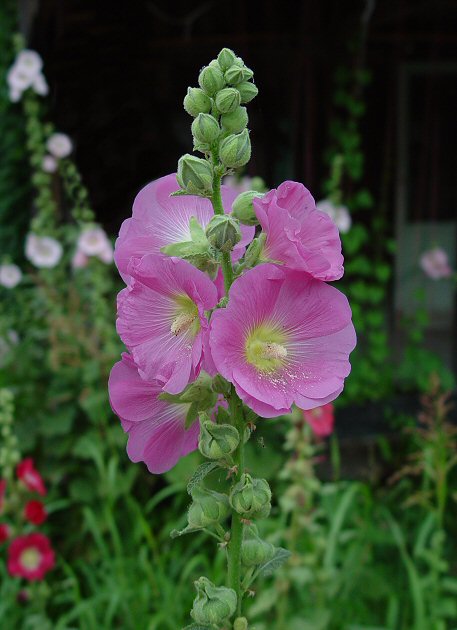Alcea rosea L.
Hollyhock

Introduced
CC = *
CW = 5
MOC = 11
© DETenaglia
Alcea rosea L.Hollyhock | |
 |
Introduced CC = * CW = 5 MOC = 11 |
© DETenaglia |
|
Family - Malvaceae Stems - To 3m tall, erect, herbaceous, stout, typically simple, from taproot, ribbed, glabrous to densely stellate pubescent.
Leaves - Alternate, petiolate. Petioles to +15cm long, scabrous, stellate pubescent. Blades to +20cm broad and long, shallow 3-5-lobed, crenate, rugose and stellate pubescent above, much more pubescent below, venation prominent below.
Inflorescence - Terminal raceme to +50cm long(tall). Flowers each subtended by serrate stipules. Teeth of stipules with forked ciliate margins, acute. Pedicel to +1cm long, densely stellate pubescent. Involucre subtending the calyx densely stellate pubescent externally, glabrous internally, not exceeding the calyx. Each bract of involucre with 6-7 teeth. Flowers - Corolla typically deep rose or wine colored, yellowish at base, to +/- 10cm broad. Petals 5, joined at base to stamen column, glabrous except for marginal floccose hairs at base internally. Stamens many, combined into a column with anthers at the apex. Free portion of filaments whitish, glabrous, 2-3mm long. Styles united basally for about 1/2 their length, exceeding the staminal column, glabrous. Ovary of +/-50 carpels, 5-sided in cross section. Calyx 5-lobed, densely stellate pubescent externally, glabrous internally. Lobes acute, +/-2cm long.
Flowering - May - September. Habitat - Cultivated, rarely escaping to waste ground and disturbed sites. Origin - Native to Europe. Other info. - This species is easy to grow and very popular in cultivation in Missouri. The corolla, while typically a pinkish-rose color, may be anywhere from whitish to deep purple. Photographs taken in in Van Buren, MO., 6-15-04. |